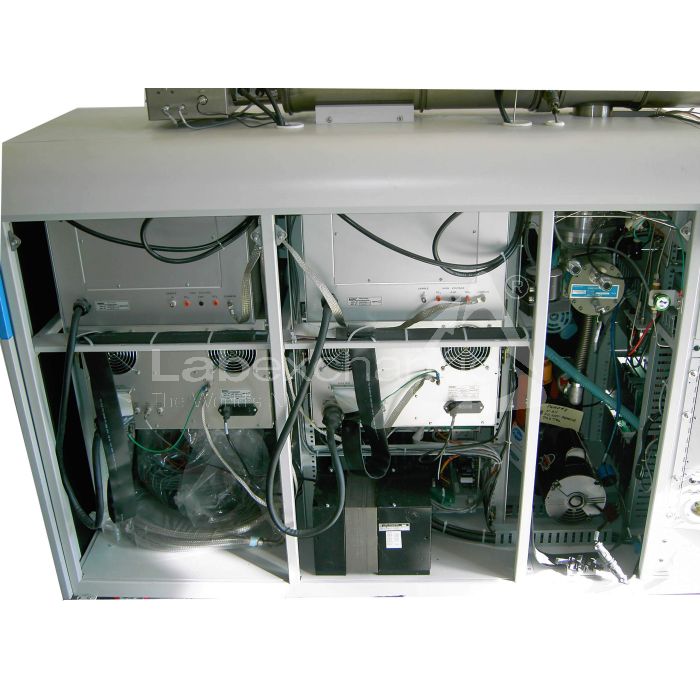Perkin Elmer API III
| Objektnummer | B00012132 |
|---|---|
| ID-Nummer | 012132 |
| Objektbezeichnung | Perkin Elmer API III |
| Status | Archiviertes Produkt |
Produktgruppe: LC / MS
Status, Liefer- und Zahlungsbedingungen
Geräteüberprüfung
Die gebrauchten Laborgräte werden vor der Auslieferung von der Labexchange Service GmbH überprüft. Sie erhalten voll funktionsfähige Geräte.
Versandzeit
Die angegebenen Versandzeiten sind die jeweils kürzesten für einen Artikel. Die tatsächlich Versandzeiten können im Einzelfall davon abweichen. Die endgültigen Versandzeiten werden in der Auftragsbestätigung angegeben.
Bei Bestellung/Anfrage von mehreren Artikeln bieten wir grundsätzlich Sammellieferung an. Die Versandzeit berechnet sich nach der Position mit der längsten Versandzeit. Auf ausdrücklichen Wunsch ist eine Teillieferung möglich.
Versandarten
Paketdienste, Speditionen, Selbstabholung, Lieferung durch Labexchange-Fuhrpark
Lieferinformationen
Unsere Lieferbedingungen sind grundsätzlich zzgl. Versandkosten. Angegebene Versandkosten sind zu erwarten. Falls anfallende Versandkosten nicht angegeben sind, fragen Sie diese bitte gesondert an.
Die angegebenen Fracht- und Verpackungskosten beziehen sich auf den günstigsten Transportweg und sind vorbehaltlich unvorhergesehener Kostensteigerungen. Durch unvorhersehbare Ereignisse können sich die Frachtraten und die Lieferzeiten jederzeit ändern und müssten der aktuellen Situation angepasst werden. Incoterm-Kodierung gemäß Incoterms 2010: Bei Selbstabholung EXW, bei Sendungen per Schiff CFR, per Luftfracht CPT, übrige Sendungen DAP. Hinweis für Auslandssendungen: Ein Präferenznachweis/EUR1 wird von uns nicht ausgestellt. Bei Selbstabholung/EXW aus Drittländern und der EU werden 16% MWSt als Kaution einbehalten bis wir die Gelangensbestätigung/den Verbringungsnachweis des Käufers erhalten haben.
Zahlungsbedingungen
Wir akzeptieren keine Zahlung per Letter of Credit, PayPal etc. Der Rechnungsbetrag ist in jedem Fall ohne Abzug fällig. Die Ware bleibt bis zur vollständigen Bezahlung unser Eigentum. Skonto wird nicht gewährt.
|
Land |
Mögliche Zahlungsarten |
Bemerkung |
|
DE, AT, CH |
Rechnung, Vorkasse, Kreditkarte |
Eine Zahlung per Rechnung ist nur für Firmenkunden möglich. |
|
NL, BE, LU |
Rechnung, Vorkasse, Kreditkarte |
Eine Zahlung per Rechnung ist nur für Firmenkunden möglich. |
|
Alle weiteren Länder |
Vorkasse, Kreditkarte |
|
Es gelten unsere Allgemeinen Verkaufs-, Lieferungs- und Zahlungsbedingungen. Diese finden Sie hier. Zwischenverkauf, sowie Irrtum und Preisänderungen sind vorbehalten.
Statusdefinition
Alle Artikel sind gebrauchte Artikel, es sei denn ein Artikel wird explizit als Neugerät aufgeführt.
|
Status |
Zustand |
Bemerkung |
|
Sofort verfügbar |
gebraucht |
Der Artikel wurde bereits überprüft und befindet sich in einem einwandfreien Zustand. Er kann direkt an Sie versendet werden. |
| Lagergerät |
gebraucht |
Der Artikel befindet sich in unserem Lager. Unsere Techniker werden den Artikel vor der Auslieferung überprüfen. Sie erhalten voll funktionsfähige Artikel. |
|
Anbieter |
gebraucht |
Der Artikel befindet sich noch beim Anbieter. Nach Ihrer Bestellung wird er von uns angekauft, überprüft und an Sie versendet. Ein Funktionszertifikat und ein Servicebericht sind bei der Lieferung enthalten. |
|
Neugerät |
neu |
Es handelt sich um einen fabrikneuen Artikel. Es gelten die Garantiebestimmungen des Herstellers sowie die gesetzliche Gewährleistungsfrist. |
|
Labprocure |
gebraucht |
Verantwortlich für den Inhalt dieses Geräteangebotes ist die Labprocure GmbH als Geräteinserent. Labprocure übernimmt die Haftung für die hier inserierten Angebote und für die beinhalteten Fotos und Angebotstexte. Labprocure GmbH, Bruckstrasse 58, 72393 Burladingen. |
Firma: Perkin Elmer
The API III system consists of the API III LC/MS/MS and an Apple Macintosh Computer with associated peripherals. A powerful and versatile system, the API III provides the capability of analyzing liquid streams for polar compounds. The term LC/MS/MS is used as a generic description of the separation and analysis processes which are provided by the system, including separation by Liquid Chromatography, CZE, IC and potentially ITP, and analysis by either MS or MS/MS.
In general, the amount of separation (chromatography) required is determined by the type of sample and the complexity of the matrix. In some cases, samples can be introduced directly with no separation, either by flow injection through an injection loop or by pumping the sample continuously through either an LC pump or the syringe drive provided with the system. In other cases, chromatography is required in order to separate the analyte from the matrix, thereby providing both added information (retention time) and reduced matrix effects. Similarly, some analyses may require the specificity of MS/MS for identification or confirmation, while others require only molecular weight information (provided by MS).
All of these combinations are available with the API III. It is up to the analyst to determine which mode of operation best satisfies the requirements of the analysis: chromatography or direct injection; MS or MS/MS; full scan, selected ion monitoring (SIM), or multiple reaction monitoring (MRM); or other MS/MS scan modes such as parent scan or constant neutral loss scan.
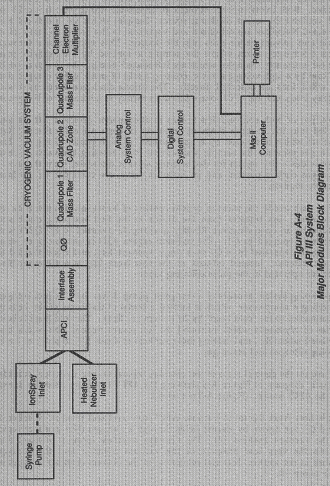
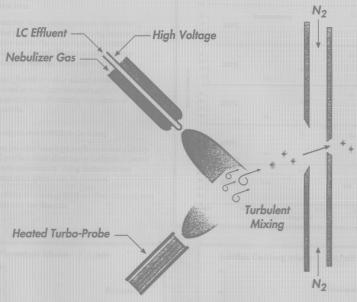

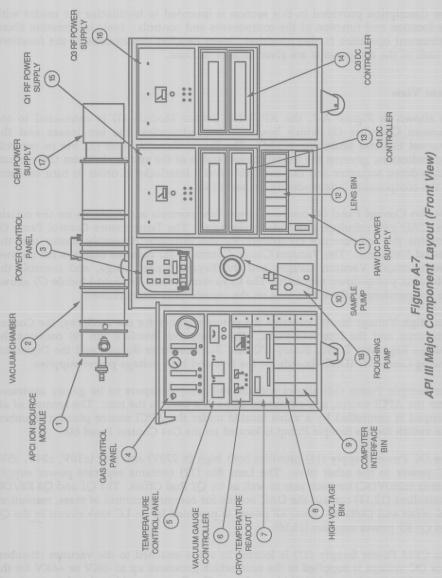
Positioning the Sample Inlets
Important: The ground plug for the IonSpray and Heated Nebulizer Inlets must be plugged in to activate an interlock which turns on the high voltage power supplies. When shutting down the system, remove the ground plug before closing the Ion Gate Valve.
The Ions created by both sample inlets are drawn into the mass analyzer by the electrical potential difference between the orifice and the tip of the IonSpray or, in the case of the Heated Nebulizer, the tip of the Corona Discharge Needle not between the orifice and the nebulized spray itself. Therefore, the spray should be directed away from the orifice for maximum sensitivity, to reduce chemical noise, and to prevent the orifice from possible plugging.
Consider the Interface Plate to be a clock face with the orifice representing the center of the clock:
IonSpray
The spray should be aimed at about 3 o'clock, 0.5" (1.2 cm) to the right of the orifice. The tip of the IonSpray should be about 1" (2.5 cm) back from the Ion Gate Valve (or set at the 2.5" mark on the z-axis scale). The IonSpray nebulizer tube should be at an angle of about 45 to 600 with respect to the Interface.
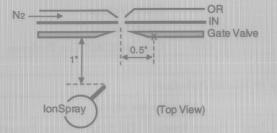
Heated Nebulizer
Turn the two positioning knobs on the Multi-purpose Front End counterclockwise to the end of their travel, then turn the adjusting knobs clockwise one turn. The spray should be aimed at about 1 o'clock, 1" (2.5 cm) to the right of the orifice. The tip of the probe should be about 1 to 3" (2 to 7.5 cm) back from the Ion Gate Valve.
The Corona Discharge Needle tip should be located slightly off-axis, about half-way between the tip of the probe and the Interface.
Operating the Heated Nebulizer
Turn on the Sample Pump and make sure that it is venting the plenum chamber. By adjusting the valve at the bottom of the plenum chamber, obtain a Source Delta P value of 0.8" H 2 O. With the Auxiliary and Nebulizer Gases flowing, increase the Heated Nebulizer's temperature to 400°C. After 5 minutes of warming, start the LC solvent flowing at 1 mL/min and increase the temperature to 480°C. This indicated temperature produces vapour temperatures of approximately 100°C. To prevent damage to the Heated Nebulizer, do not start the LC solvent flowing if the temperature is above 400°C.
|
Sample Inlet Voltage Settings |
|
|||
|
IonSpray |
Positive Ion Mode - ISP |
(Normal Range) |
Negative Ion Mode - ISN |
(Normal Range) |
|
ISV (volts) OR (volts) |
4800 60 |
(4000 to 5500) (35 to 150) |
-3800 -55 |
(-3000 to -4500) (-35 to -120) |
|
Heated Nebulizer |
Positive Ion Mode - HNP |
(Normal Range) |
Negative Ion Mode - HNN |
(Normal Range) |
|
Dl (microamps) OR (volts) |
3 60 |
(3 to 5) (35 to 120) |
-3 -55 |
(-3 to -5) (-35 to -120) |
|
Note: ISV and Dl are Iinked such that when either one of the parameters is selected, the other parameter automatically changes to a default value. |
||||
|
Sample Inlet Conditions |
|||||
|
lonSpray |
|
(Normal Range) |
Heated Nebulizer |
|
(Normal Range) |
|
Curtain Gas (N 2 ) |
0.6 L/min |
(0.6 to 1.8) |
Curtain Gas (N 2 ) |
0.6 L/min |
(0.6 to 1.8) |
|
Nebulizer Gas Flow |
40 psi |
|
Nebulizer Gas Flow (N 2 ) |
80 psi |
(40 to 100) |
|
Liquid Flow |
40 µL/min |
(1 to 200) |
Auxiliary Gas Flow(N 2 ) |
1 L/min |
(0.5 to 3) |
|
Interface Heater Liquid Flow for PPGs |
60°C 5 µL/min |
|
Temperature |
480°C |
(400 to 500) |
Note: The values given are intended as a general guide and may not be optimum for all systems.

Dl Discharge Needle Current
ISV IonSpray Voltage
IN Interface Plate Voltage
OR Orifice Plate Voltage
RO Q0 Rod Offset Voltage
M1 Q1 Park Mass
RE1 Q1 Resolution
DM1 Q1 Delta Mass
R1 Q1 Rod Offset Voltage
L7 Lens Element 7 Voltage
R2 Q2 Rod Offset Voltage
M3 Q3 Park Mass
RE3 Q3 Resolution
DM3 Q3 Delta Mass
R3 Q3 Rod Offset Voltage
L9 Lens Element 9 Voltage
FP Faraday Plate Voltage
MU Channel Electron Multiplier (CEM) Voltage
CC Count Control
CGT Collision (CAD) Gas Thickness
|
Ion Path Parameter Voltage Settings (IonSpray or Heated Nebulizer) |
||||
|
MS |
Positive Ion Mode |
Negative Ion Mode |
||
|
|
Q1 Scan (Norm. Range) |
Q3 Scan (Norm. Range) |
Q1 Scan (Norm. Range) |
Q3 Scan (Norm. Range) |
|
IN |
650 |
650 |
-650 |
-650 |
|
RO |
30 |
30 |
-30 |
-30 |
|
R1 |
27 (26 to 28) |
27 (26 to 28) |
-27 (-26 to -28) |
-27 (-26 to -28) |
|
R2, L7 |
-50 (0 to -150) |
-50 (0 to -150) |
20 (0 to 150) |
20 (0 to 150) |
|
R3 |
-50 (0 to -100) |
27 (26 to 28) |
50 (0 to 100) |
-27 (-26 to -28) |
|
L9, FP |
-250 (0 to -250) |
-250 (0 to -250) |
250 (0 to 250) |
250 (0 to 250) |
|
MS/MS* |
Positive Ion Mode (Normal Range) |
Negative Ion Mode (Normal Range) |
||
|
OR |
60 (35 to 120) |
-60 (-35 to -120) |
||
|
R2 = R3** |
-30 (-100 to 30) |
30 (-30 to 100) |
||
|
CC |
1 (1 or 10) |
1 (1 or 10) |
||
|
CGT |
400 (200 to 600) |
400 (200 to 600) |
||
|
* Ion Energy = RO - R2. The MS/MS state File should include the PPG state File values for RE1, DM1, RE3 and DM3. Additional sensitivity can be obtained by Iowering the resolution, i.e. by decreasing RE1 (or RE3) and/or increasing DM1 (or DM3). Note that the RE and DM values should be the same value and polarity whether in positive or negative ion mode. ** Use R2 = R3 for high sensitivity or for MS/MS of multiply charged ions. Use R3 Auto Scan Function for high resolution of singly charged parent ions where R3 = R2 + (R1-R2)(M3/Ml) . |
||||
Scan Conditions |
||||
|
|
Ml or Profile |
MRM or Ml with zero width |
Q1 or Q3 Scan |
Daughter, Parent or Neutral Loss Scan |
|
Step (amu) |
0.1 (0.05 to 0.25) |
not used |
0.1 (0.1 to 1.0) |
1.0 (0.1 to 1.0) |
|
Dwell (msec) |
10 |
100 |
1 |
5 |
|
Mass Defect (millimass units per 100 amu) |
not used |
not used |
not used |
compound dependent, e.g. 55 for peptides, use when Step > 0.2 |
Note: The values given are intended as a general guide and may not be optimum for all systems. If a parameter value is not given, it is assumed to be the PPG state file value.

